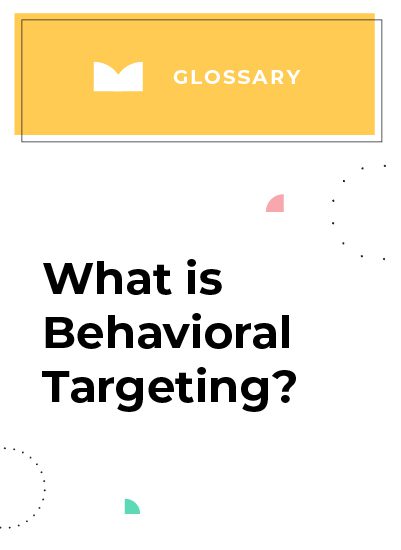
Behavioral Targeting
What is Behavioral Targeting?
Behavioral targeting is the ability to focus a marketing message on an individual based on their past interactions with your site. Behaviors you may wish to target include events such as when a customer browses a specific product category, adds an item to their cart without converting, or returns to your site after a long absence.
What are the Benefits of Behavioral Targeting?
Whether your company is looking to increase sales or sell more products, behavioral targeting can deliver these benefits to help improve the bottom line. In turn, consumers are presented with more relevant information and items that matter to them. Below are the benefits of behavioral targeting for organizations and their customers.
Behavioral Targeting Benefits for Organizations
1. Increase Click Through Rates
By serving more targeted ads, web copy or products, users are more inclined to click through to find items more relevant to them.
2. Increase Conversions Rates
If ads are more relevant, users are more likely to make a purchase. This leads to more successful campaigns and has a direct impact on the bottom line.
3. Target Based On Data
Making assumptions about your customers can have a negative impact on revenue. Learn more about customers and those visiting your site. Target them based on real data, instead of guesses or stereotypes.
Benefits of Behavioral Targeting for Consumers
1. An Improved Shopping Experience
By being redirected to products relevant to them, users will have an easier time finding items they like in less time.
2. Product Alerts
By seeing ads for new products, users can easily stay up to date on brands they enjoy and information relevant to them.
Understanding your Customers
Before you can segment visitors your site, you should understand key characteristics about their habits and demographics. By understanding your customer on these levels, you can further provide them with more relevant and contextual ads, web site copy or product recommendations. Below is some information your team can collect to get you started:
-
Cookie Data
- Cookies in mobile devices, laptops and tablets can help unlock how to target potential customers. By understanding browser history and social media patterns, you can create more targeted ads and serve them on more relevant platforms.
-
Geographic Location
- Through a user’s IP address, you can understand where users live and what region they work in. If your business has localized deals or products that only appeal to a certain region, this information can be useful in making sure you are addressing the right audience.
-
Web Pages Viewed
- Are your users visiting the same page or the same section of a site? How many times do they visit a page before making a purchase? Understanding what pages a user is visiting and how often they are browsing before making a purchase can help you cater messaging to drive a sale. If they frequently visit the shoes section of your site, customizing the homepage with advertisements related to the latest arrivals in that department could help encourage a purchase.
-
Purchase History
- Behavioral targeting can also involve collecting purchase history data to make predictions about what users will purchase next. If users leave their cart without checking out or buy the same type of product each time they shop, you will be able to target them with messaging to either increase the sale or close the deal.
-
Duration of Visits
- Are customers staying on your site for extended periods of time or do they quickly make a purchase without browsing? Visibility around how your customers like to shop or if there are missed opportunities to showcase products can help you better segment the data.
-
Time Between Visits
- If users are visiting your site frequently, you will need to target them differently than users who rarely visit your site. Time between visits can help you differentiate between customers who have a strong preference to your brand and those who don’t.
How does Behavioral Targeting Work?
Once the above data is collected, users are segmented into profiles and lists. These segments can be based on purchase intent, browser history or purchase history. These segments help marketers target users with specific ads, products, or messaging that will relate to the group to drive higher sales and revenue. A Data Management Platform is often needed to collect the data and to keep it organized.
Collect and Analyze the Data
- Collect data on those who visit your site. The more data you collect, the better your targeting will be. Complement the data you have from third party cookies with registered user profiles and other marketing pixels.
Segment Your Audience
- Segment audiences based on past behaviors (Users who like shoes, users who like cooking, etc) to better understand your audiences. Alternatively, envision what the goal is for your next campaign and align your segmentation with this goal. For example, if you’d like to upsell customers, segmenting users on past purchases can help suggest the right products to increase a sale.
Apply the Data
- Implement messaging targeting the above segment groups based on their interests in your campaigns, web copy and product recommendations.
Analyze the Results
- What are your results? Are you seeing an improvement in conversions or are they remaining the same? Do you understand your audience well enough? You may need to segment audiences differently or may want to test various messages across segments. Testing and analyzing the results is a crucial step when it comes to behavioral targeting.

Final Thoughts
Behavioral targeting is another tool to help you improve your marketing by speaking with customers with messaging that is relevant to them. Tools such as the Monetate Personalization machine learning algorithms decide which data is most relevant and which action will have highest probability of achieving a specific outcome such as increased average order value (AOV) or conversion rate.